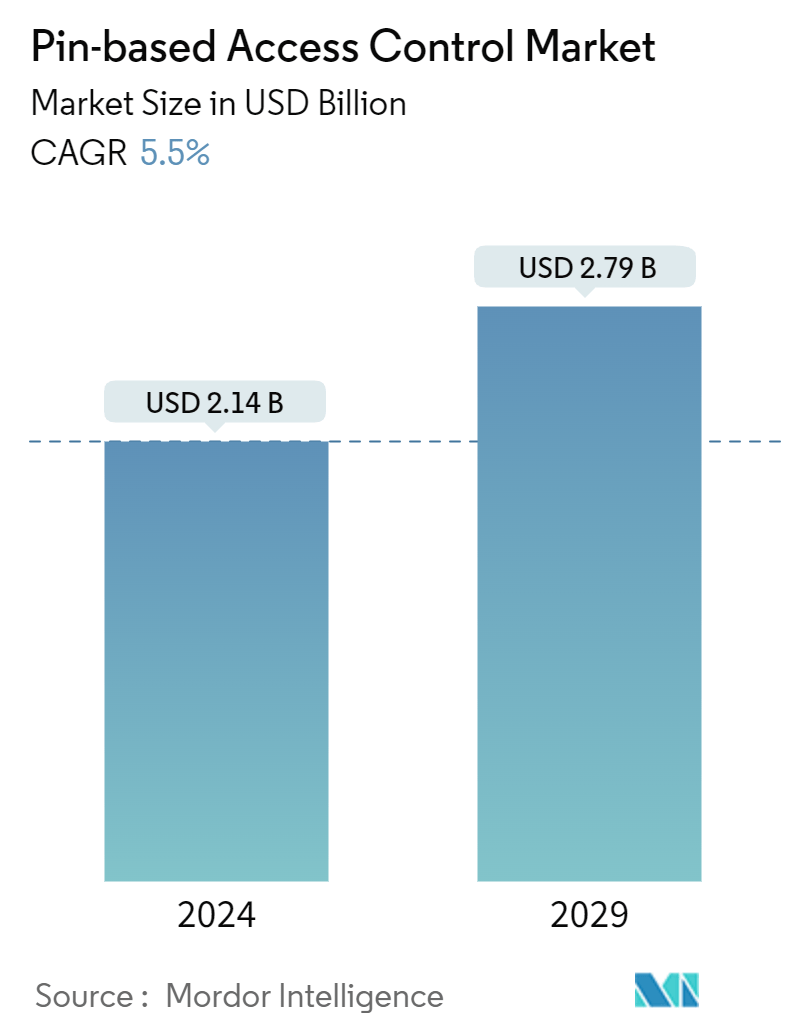Market Size of Pin-based Access Control Industry

| Study Period | 2019 - 2029 |
| Market Size (2024) | USD 2.14 Billion |
| Market Size (2029) | USD 2.79 Billion |
| CAGR (2024 - 2029) | 5.50 % |
| Fastest Growing Market | Asia Pacific |
| Largest Market | North America |
| Market Concentration | Low |
Major Players
*Disclaimer: Major Players sorted in no particular order |
Pin-based Access Control Market Analysis
The Pin-based Access Control Market size is estimated at USD 2.14 billion in 2024, and is expected to reach USD 2.79 billion by 2029, growing at a CAGR of 5.5% during the forecast period (2024-2029).
- Pin-based access control systems have become crucial to managing access to commercial offices, businesses, and residential buildings. These systems offer enhanced property security for tenants and staff, who can quickly enter with credentials while denying access to unauthorized individuals. The increasing privacy and security concerns and the increasing theft of crucial data and information contribute to the market's growth.
- The number of burglaries and crimes has increased across the world in the past few years. This has heightened concerns about the safety of people, assets, and processes, resulting in severe damage to infrastructure and the loss of multiple lives.
- According to the Council on Criminal Justice (CCJ), motor vehicle theft, a crime that began surging in the summer of 2020, maintained its upward trend through 2023, with a 29% increase in reported thefts compared to 2022 in the United States. Whereas residential burglary rates across cities in the United States were 26% lower in 2023 than in 2019, they saw a 3% decline from 2022, marking a reduction of 1,052 incidents. Residential burglary dropped by 4% in the first half of 2023 and 1% in the latter half compared to the same periods in 2022. There are many technologies that can help in decreasing the crime rate. One of them is pin-based access control.
- Furthermore, pin-based access controls are easily scalable, making them suitable for SMEs who want to secure their data without having to spend extra money. Several pin-based access control systems can track who accessed a particular area along with time. These systems are often compatible with the existing infrastructure, making them a convenient choice to integrate into older security systems.
- Biometric authentication is rapidly increasing across various industries because of the provision of secure identity verification processes. This technology uses physical characteristics like facial recognition, fingerprint scan, voice recognition, and retina recognition to authenticate the user. The necessity for strict identity verification due to the accelerating adoption of transactional technologies is increasing the demand for biometrics access controls, which are preferred by consumers over the traditional pin-based access control, hindering the growth of the market.
- Rising inflation rates are driving up the prices of goods and services, notably increasing the cost of access control systems. These heightened costs are eroding purchasing power for both consumers and businesses, consequently hampering the market's growth. Moreover, the ongoing conflict between Russia and Ukraine is severely disrupting the global supply chain, especially in the realm of electronic components and raw materials essential for access control systems. As a result, manufacturers are facing production delays and escalating costs.
Pin-based Access Control Industry Segmentation
PIN-based access control is a technology-driven security solution that employs a two-level authentication model. It is suggested to use access control PINs, typically consisting of four to six digits, although longer PINs are advisable. The study tracks the revenue acquired through the sale of PIN-based access control hardware and software by various players across the world. The study also tracks the key market parameters, underlying growth influencers, and major vendors operating in the industry, which supports the market estimations and growth rates during the forecast period. The study further analyses the overall impact of the aftereffects of the COVID-19 pandemic and other macroeconomic factors on the market. The report’s scope encompasses market sizing and forecasts for the various market segments.
The pin-based access control market is segmented by component (hardware and software), organization size (SMEs and large enterprises), end-user industry (banking and financial services, government services, retail, IT and telecommunications, healthcare, power and utilities, residential, and other end-user industries), and geography (North America, Europe, Asia-Pacific, and Rest of the World). The market sizes and forecasts are provided in terms of value (USD) for all the above segments.
| By Component | |
| Hardware | |
| Software |
| By Organization Size | |
| SMEs | |
| Large Enterprises |
| By End-user Industry | |
| Banking and Financial Services | |
| Government Services | |
| Retail | |
| IT and Telecommunications | |
| Healthcare | |
| Power and Utilities | |
| Residential | |
| Other End-user Industries |
| By Region*** | |||||
| |||||
| |||||
| |||||
| Australia and New Zealand | |||||
| Latin America | |||||
| Middle East and Africa |
Pin-based Access Control Market Size Summary
The pin-based access control market is experiencing significant growth, driven by the increasing need for enhanced security in commercial and residential settings. These systems are essential for managing access to sensitive areas, offering a reliable solution to prevent unauthorized entry. The rising concerns over privacy and security, coupled with the growing incidence of theft and crime, are propelling the demand for pin-based access control systems. These systems are particularly appealing to small and medium enterprises due to their scalability and compatibility with existing infrastructure, making them a cost-effective choice for securing data and assets. However, the market faces challenges from the rising costs of goods and services, influenced by inflation and global supply chain disruptions, which are impacting the affordability and availability of these systems.
The market is characterized by a competitive landscape with numerous players striving to enhance their market presence through product innovation and strategic partnerships. The United States leads in the adoption of pin-based access control systems, particularly in sectors such as finance, retail, and hospitality. Meanwhile, the Asia-Pacific region is emerging as a fast-growing market, driven by urbanization, industrialization, and the increasing demand for security solutions in countries like China and India. Technological advancements, such as the integration of biometric features and smart door locks, are further shaping the market dynamics. Despite the challenges, the ongoing development of advanced access control solutions and the growing awareness of security needs are expected to sustain the market's growth trajectory.
Pin-based Access Control Market Size - Table of Contents
-
1. MARKET INSIGHTS
-
1.1 Market Overview
-
1.2 Industry Attractiveness - Porter's Five Forces Analysis
-
1.2.1 Bargaining Power of Suppliers
-
1.2.2 Bargaining Power of Consumers
-
1.2.3 Threat of New Entrants
-
1.2.4 Threat of Substitutes
-
1.2.5 Intensity of Competitive Rivalry
-
-
1.3 The Impact of Aftereffects of the COVID-19 Pandemic and Other Macroeconomic Factors on the Market
-
-
2. MARKET SEGMENTATION
-
2.1 By Component
-
2.1.1 Hardware
-
2.1.2 Software
-
-
2.2 By Organization Size
-
2.2.1 SMEs
-
2.2.2 Large Enterprises
-
-
2.3 By End-user Industry
-
2.3.1 Banking and Financial Services
-
2.3.2 Government Services
-
2.3.3 Retail
-
2.3.4 IT and Telecommunications
-
2.3.5 Healthcare
-
2.3.6 Power and Utilities
-
2.3.7 Residential
-
2.3.8 Other End-user Industries
-
-
2.4 By Region***
-
2.4.1 North America
-
2.4.1.1 United States
-
2.4.1.2 Canada
-
-
2.4.2 Europe
-
2.4.2.1 United Kingdom
-
2.4.2.2 Germany
-
2.4.2.3 France
-
-
2.4.3 Asia-Pacific
-
2.4.3.1 China
-
2.4.3.2 India
-
2.4.3.3 Japan
-
-
2.4.4 Australia and New Zealand
-
2.4.5 Latin America
-
2.4.6 Middle East and Africa
-
-
Pin-based Access Control Market Size FAQs
How big is the Pin-based Access Control Market?
The Pin-based Access Control Market size is expected to reach USD 2.14 billion in 2024 and grow at a CAGR of 5.5% to reach USD 2.79 billion by 2029.
What is the current Pin-based Access Control Market size?
In 2024, the Pin-based Access Control Market size is expected to reach USD 2.14 billion.

